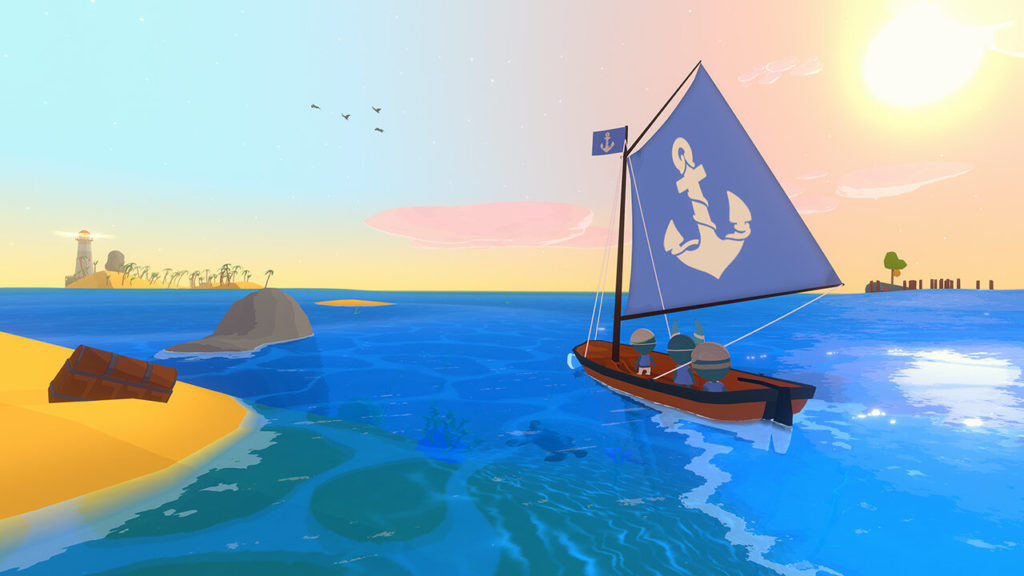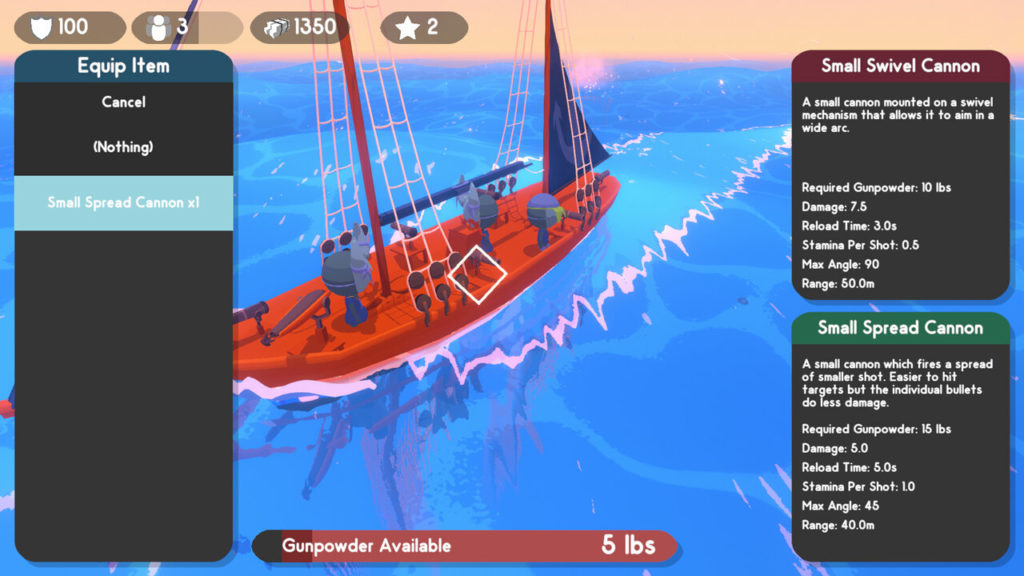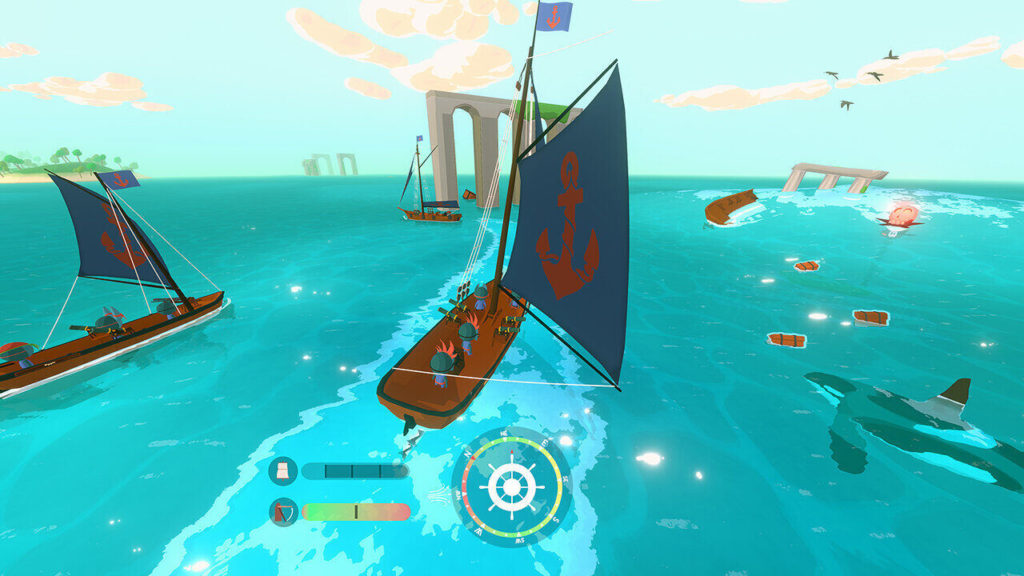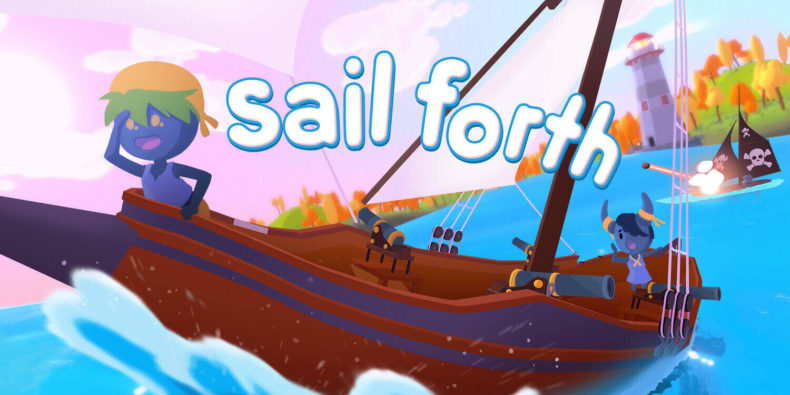December 21, 2022
When it comes to sailing the seas in video games, I’m pretty well versed in hoisting the mainsail and tacking against the wind. Most of this is due to an ungodly amount of time spent hunting down other players and digging up treasure in Sea of Thieves. For many years I found a new home on the digital waves, and even after going cold turkey this year Ship of Fools brought me back to a life of cannon fire and hole repairing. When I saw Sail Forth shadow drop its colourful boat adventure during Nintendo’s House of Indies event I was excited to get back on the water and start exploring.
Exploring really is the name of the game in Sail Forth. The moment you boot up the game you’re dropped into a small watery area on a dinky little wooden boat and after a few quick tutorials are sent on your way to scour the vast expanse of water for supplies, potential crewmates and maybe even a pirate or two.
It’s easy enough to learn how to control your ship at a basic level, but there are a few systems to master. By pressing A multiple times you’ll raise more and more sails until you hit top speed, whereas B lowers them if you need to check something out and holding the button once you stop even allows you to row backwards slowly. Outside of simple acceleration, your main foe in terms of getting around is the wind. The shoulder buttons control the tilt of your sail, and you’ll need to get that angle just right if you want to hit top speeds. When the wind is acting up and blowing against you then sail tilting is key, and if you don’t line it up just right you’ll stop moving entirely.

Once you’ve gotten used to getting around it’s time to get to grips with everyone’s favourite boat weapon, the cannon. By holding down the aim button you can see the areas that each cannon equipped to your ship can reach, and then it’s just a case of pointing and shooting. There’s plenty of things worth blasting in the world of Sail Forth, from people on land and sea creatures in the depths to crates full of goodies.
There’s a nice variety of friends, foes, and items littering the seas, and exploring never feels like a chore. Initially I thought that having smaller maps instead of a single sprawling ocean to explore was a little disappointing, but it means that you’re never sailing for longer than a couple of minutes between points of interest. Islands are usually the best place to start, because boxes and enemies drop planks (which can be used to repair the ship or as currency) and map fragments which will add a new location to your world map and allow you to move forward on your adventure.
Planks really make the world go round in Sail Forth. You’ll get them as rewards for completing tasks like transporting an item to another map or saving a ship from pesky pirates, and can spend them on upgrades, crew or even entirely new ships. Each boat you can buy has its own strengths and weaknesses. Maybe you want a big galleon that fits lots of people and cannons on board, and don’t mind sacrificing maneuverability. Or if you’re like me you’ll manage with less cannons and buddies so you can whip the boat around at a moment’s notice. As long as you have the wood the world is your oyster.

More than anything though I liked to spend my spare planks on new cannons. Cannons are not created equal in Sail Forth, and have different power levels, reload speeds and ranges to experiment with. My absolute favourite though was a cannon that fired a spread shot. The idea of a cannon that’s essentially a shotgun is just fantastic, and regardless of its short range I always made sure I strapped one to my boat whenever possible.
Not everything has to be aggressive when sailing the seas however. You have a camera to take photos of beautiful flora and fauna, as well as a fishing rod you can use to catch a variety of colourful fish. These are nice distractions from steering and shooting, and photos and seafood can even be traded in at an outpost for some bonus planks.
I really enjoyed my time floating in the ocean in Sail Forth, but it isn’t without a few issues. The first is just how lifeless the game feels sometimes. There’s plenty to do around the world, but every beach and other ship looks the same and none of the characters really move. Sailing across the sea should feel magical, but when all your characters are stood rigid on the spot the immersion is pretty much broken.

The gameplay loop also has a pretty major issue, which comes when finding shards of map. Sometimes these just don’t spawn when you enter a new area, which means you need to go back and forth between different zones (with a bit of loading each time) and break the respawning boxes over and over again. It’s a tad tedious, and just makes exploring feel more like a job than an adventure.
I should also mention the performance on the Switch, which can be a little bit ropey. The framerate is an issue throughout, with certain more action packed moments causing it to tank significantly. It’s a shame that there are so many things that can take you out of this cosy explorative game, because when everything clicks it’s lovely.
Sail Forth is an enjoyable boat filled adventure that just has a few issues that hold back the cosy nautical good time. Exploring the world is a treat though, and the different activities located on the waves are varied and entertaining. If you can cope with the Switch performance and don’t mind some repetitive moments then it’s worth setting sail for a relaxing day at the seaside.
Exploring the sea is relaxing and compelling
It feels great to customise your ship to suit your playstyle
Lots to do on the waves
Nice and colourful
The world sometimes feels a bit lifeless
Switch performance isn't great
Can be repetitive
Sail Forth isn't without a few issues, but exploring the seas and upgrading your ship is satisfying from start to finish.





